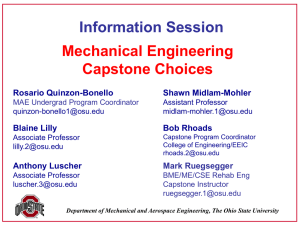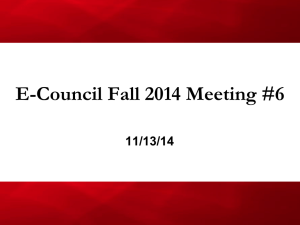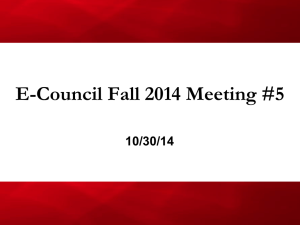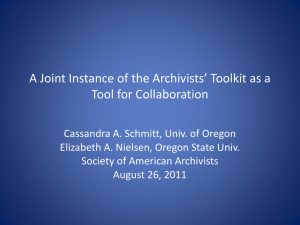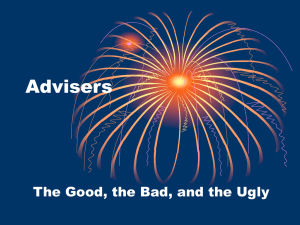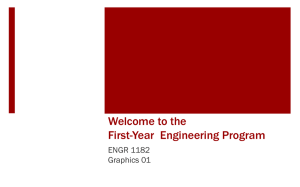shrs Majors - The Ohio State College of Medicine
advertisement
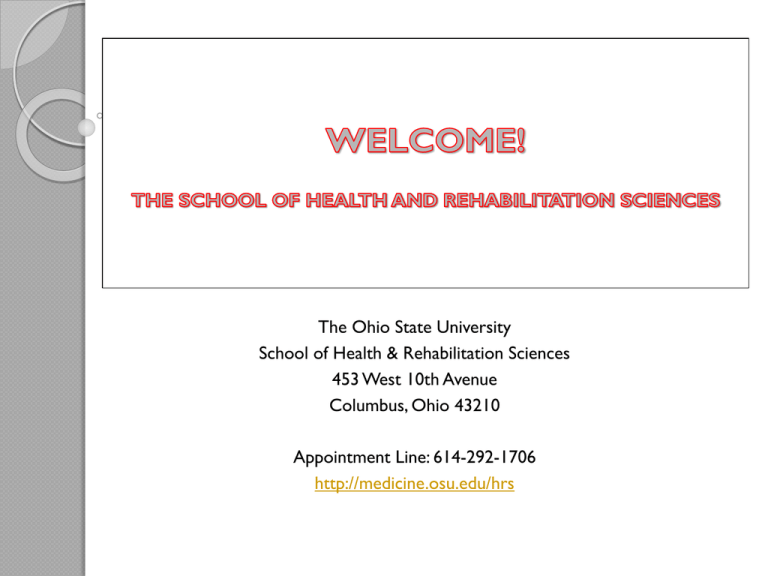
The Ohio State University School of Health & Rehabilitation Sciences 453 West 10th Avenue Columbus, Ohio 43210 Appointment Line: 614-292-1706 http://medicine.osu.edu/hrs SHRS STUDENT SERVICES TEAM Lisa Terek o Director of Student Affairs Shannon Peltier o Pre-Major Advisor Shannon.Peltier@osumc.edu Breanna Trautman o Pre-Major Advisor Breanna.Trautman@osumc.edu Christie Lukegord o Health Sciences Advisor Jennifer Hicks o Graduate Studies Advisor o Judy Froling o Office Associate INTRO TO SHRS WHAT IS THE FIELD OF HEALTH & REHABILITATION SCIENCES? • Health and rehabilitative professionals are clinical and administrative health care professionals distinct from medicine, dentistry, and nursing. • Health and rehabilitative professionals make up 60% of the total health workforce. •They work in health care teams to make the healthcare system function by providing a range of diagnostic, technical, therapeutic, and direct patient care that are critical to the other health professionals they work with and the patients they serve. SHRS MAJORS • • • • • • • 5 Athletic Training (AT) Health Information Management & Systems (HIMS) Health Sciences (HS) Medical Dietetics (MD or Med Diet) Medical Laboratory Science (MLS) 1) Certification 2) Medical Science (Pre-Med) Radiologic Sciences & Therapy (RST or Rad Sci) 1) Radiography 2) Diagnostic Medical Sonography 3) Radiation Therapy Respiratory Therapy (RT) WHAT MAKES SHRS MAJORS DIFFERENT? SOME DIFFERENCES Minimum 2.5 GPA to declare / remain a SHRS student Additional fee per term ◦ Students have access to free printing in Atwell’s computer labs, weekly drop-in hours with advisors, & a weekly pre-major email Different General Education requirements ◦ No foreign language requirement ◦ Waive Global Studies requirement for students who transfer 15+ credit hours into OSU Pre-major/major student body structure ◦ Competitive Admissions Majors COMPETITIVE ADMISSIONS MAJORS Start college with the desire to enter a SHRS major; at OSU consider declaring a SHRS pre-major Consult curriculum guides to find prerequisites to enroll in (earn at least a C- or better) & complete GEs, have a good GPA, do shadowing/observation/volunteering Apply online to desired major through the Professional Admissions Office (one application cycle per year- not all applicants are accepted) If admitted, complete professional coursework and clinical/lab hours or grad school prerequisites Graduate and sit for certification or apply to graduate school APPLYING TO THE MAJORS ABOUT APPLICATIONS Applications are accepted once a year and you must apply online. Each major has a significant number of prerequisites so it is important to get an early start on these courses. ◦ Application to major depends on how many prerequisites are done & which ones they are ◦ May be delayed if your Math placement is not high enough to start a science in your 1st term SHRS PREREQUISITES Admission Pre-requisites: minimum prerequisites for eligibility to be accepted to the major ◦ 3 years to graduate ◦ Generally the professional courses are taken in the final 2 years Program Pre-requisites: minimum prerequisites for eligibility to begin the professional program ◦ Some professional program courses require additional prerequisites beyond the admission prerequisites in order to be eligible to enroll ◦ Usually 2 years to graduate Prerequisites are listed on the curriculum guides (found on the SHRS website under the Current Students tab) along with application deadlines and a proposed schedule of classes WHEN TO APPLY Usually: ◦ AT, Med Diet, Rad Sci, Respiratory Therapy During the 1st year ◦ HIMS, Health Sciences, MLS During the 2nd year Students don’t wait until all prerequisite courses are done to apply ◦ Like applying to college from high-school WHEN DO PREREQUISITES NEED TO BE DONE? Usually: ◦ AT, Rad Sci, Respiratory Therapy End of Spring semester ◦ HIMS, Health Sciences, Med Diet, MLS End of Summer semester GEs do not need to be done before applying to the major WHO IS ACCEPTED? Faculty are interested in academically prepared, eager students who are excited to join their program and have knowledge of the profession. Cumulative GPA = around a 3.0 or higher Science and Math grades = usually A’s and B’s Good Writing and Interviewing skills Related observation, volunteer, or internship experience Who, What, Where, Why, and How SHRS MAJORS Athletic Training Certified Athletic Trainers provide sports medicine care to competitive athletes in professional, college, and high-school sports as well as other physically active persons Working side-by-side with physicians, they specialize in the prevention, treatment and rehabilitation of athletic injuries It is a three year program once admitted Who are Athletic Trainers People who like working outdoors & working with their hands, & who are active People who like to help others & are assertive communicators People who like to solve problems NOT: #1 sports fans, athletes, celebrity worshipers, or gossips What’s unique in AT? 2 sequence introductory AT class (2000, 2010)- both halves will be required & cannot be taken out of sequence ◦ These are good introductory courses May Term of first year: AT 2200 (3 credits) Health Information Management and Systems (HIMS) Health information management professionals possess the skills necessary to manage the staff and systems used to collect, store, retrieve, interpret and communicate healthcare data Healthcare data is used for the planning, delivery, reimbursement, protection and evaluation of patient care HIMS skills enable professionals to work in a variety of healthcare organizations and other health-related or commercial industry settings Who are HIMS professionals? People who are organized, understand systems, like office settings, and have leadership qualities People who like to help others and communicate clearly People who want to be involved in health care but not direct patient care; advocates What’s Unique in HIMS? Sciences must be biology and chemistry ◦ Biology can be lower level ◦ Sequence is your choice Required to take Medical Terminology, not Scientific Terminology Good introductory courses: ◦ Economics and Accounting Health Sciences The rapidly changing health care world call for broadly educated professionals with extensive knowledge of health care and service related issues Health Sciences was established to prepare students for a broad range of career opportunities in health care and services or for entry into graduate and professional programs Over 80% of students pursue graduate programs after graduation Who Majors in Health Sciences? People who want to help others People who like solving problems and working in a variety of workplace settings People who are self-motivated, who want to be leaders in their fields, and who typically plan to pursue further education What makes Health Sciences unique among SHRS majors Only major that can be done part-time Requires a minor No required clinicals = scheduling flexibility Requires 12 credits of major electives Good introductory courses: ◦ Chemistry, Anatomy, Physiology Medical Dietetics Dietitians use their knowledge of practice and research in food, nutrition and health to provide the tools, education and information patients need to live healthier lives They assess patients' nutritional status and make individualized recommendations about diet and food choices that affect each patient's fitness, health and disease treatment They also assist in administration of food service systems in hospitals and other health care settings, provide nutrition services in community settings, and manage nutrition services in long-term care and sub-acute and rehabilitation centers Who are Registered Dieticians? People who like to solve complex problems within defined boundaries People who like to help others in a variety of work contexts People who like to persuade and educate others What’s Unique in Med Diet? Integrated internship Good introductory courses: ◦ Biology, Chemistry, Human Nutrition Medical Laboratory Science Medical laboratory scientists are among the most important members of the medical team They perform a full range of laboratory tests, from blood tests to complex tests that detect such diseases as cancer, AIDS and diabetes More than half of all critical detection, diagnosis and treatment decisions rely on the work of these highly trained professionals and their ability to perform and validate test results and to communicate these results to all members of the healthcare team Who are Medical Laboratory Scientists? People who like solving puzzles People who enjoy working with their hands and using tools & technology People who are organized, dependable, and who enjoy office/laboratory work and managing data What’s Unique in MLS? Two options: Certification (students who want to become Medical Laboratory Scientists) or Medical Science (students who want to pursue graduate studies in any medical field) Lab experience in class ◦ Six specialization areas Good introductory courses: ◦ Chemistry, Microbiology Good fit for students who want to work in health care but do not want direct patient contact Radiologic Sciences and Therapy Skilled professionals trained in keeping radiation exposure as low as possible while creating images of the body's internal structure Radiographers, Sonographers, and Radiation Therapists use radiation for diagnostic or therapeutic purposes Three different programs: ◦ Radiographers produce a quality X-ray image of the internal body parts for diagnostic interpretation by a physician (radiologist) ◦ Diagnostic Medical Sonographers use specialized equipment (transducers) to create images of structures inside the human body ◦ Radiation Therapists are part of the team in treating cancer Who are Radiologic Scientists? People who like to help others People who like to develop creative solutions to problems & thinking critically People who like to work with their hands and manipulating tools or operating technology What’s Unique in Rad Sci? The program encourages students to have a solid grasp of science Good introductory courses: ◦ Physics, Biology Respiratory Therapy Respiratory therapists treat patients with cardiopulmonary disorders such as asthma, emphysema, infant prematurity, and trauma They evaluate patient needs, develop respiratory care plans, educate patients and manage their respiratory care Therapists work in intensive care units, emergency departments, diagnostic laboratories, community hospitals, clinics, and in home care where they perform cardiopulmonary diagnostic tests, administer medications, assure lung inflation and airway hygiene, and provide ventilatory life support Who are Respiratory Therapists? People who like to help others and working with patients & their families across a lifespan People who like to figure out solutions to problems People who like working with tools in a variety of work settings What’s Unique in RT? Students have the option to work as a Respiratory Technologist during Senior year One of the top programs in the country! Good introductory courses: ◦ CPR, Biology NEXT STEPS WHAT TO SCHEDULE NEXT TERM FOR CURRENT OSU STUDENTS 1. Review your Degree Audit 2. Compare to the required prerequisites and GE’s to determine which courses you have taken and what you still need to take 3. Consult with an advisor WHAT TO SCHEDULE NEXT TERM FOR NON-OSU STUDENTS Review the curriculum guide 1. ◦ http://medicine.osu.edu/hrs/current-ohio-statestudents/curriculum-guides/pages/index.aspx 2. Consult with the http://admissions.osu.edu/standards to determine transfer credit – from other Ohio institutions 3. Consult with an advisor IMPORTANT!!!!! ◦ ◦ Be sure to review online curriculum guides regularly for the most up to date information regarding application dates, prerequisites, and other admission requirements for HRS programs. On the HRS website under the “Current Students” tab http://medicine.osu.edu/hrs/current-ohio-statestudents/curriculum-guides/pages/index.aspx If there is a conflict with the Degree Audit, follow the curriculum guide & consult an advisor FINDING ALTERNATIVES TO A SHRS PROGRAM Research a Plan B major ◦ Find another program at OSU that will meet your needs ◦ Consider transferring to another institution that offers a similar program to SHRS ◦ Most Important……begin researching now!!! Additional Resources available to OSU students: ◦ Exploration Advising Office http://exploration.osu.edu/ ◦ Career Connections Office http://careerconnection.osu.edu/ GENERAL EDUCATION CURRICULUM: IMPORTANT NOTES Major pre-requisites overlap with many GE categories GEs do not need to be completed prior to starting the major Since pre-requisites overlap with many GE categories, students already know what most of their GE courses are Students are generally only responsible for History GEs and Arts & Humanities GEs beyond their prerequisite courses Medicine Dentistry Optometry Veterinary Medicine Pharmacy Physical Therapy Occupational Therapy Nurse Practitioner Physician’s Assistant Master of Science/PhD of Health and Rehabilitation Sciences Public Health/Health Administration POPULAR GRADUATE PROGRAMS NEXT STEPS Remain in current major or at current university ◦ May still apply to the HRS Program ◦ Application Deadlines for Admission www.professional.osu.edu Refer to your Curriculum Guide OSU students may become a pre-Health & Rehabilitation Sciences student for next term by meeting with an advisor to declare the pre-major ◦ Complete one full term at OSU; if you are freshman or transfer student, you can not be switched until your first term grades are posted ◦ Need at least 2.5 minimum to apply for all of our programs ◦ Pre-major students must still apply to the professional program of interest NON-OSU STUDENTS WHO INTEND TO TRANSFER TO OSU PRIOR TO APPLYING TO SHRS PROGRAM: Indicate on the Common App that you are interested in a SHRS major when you apply to Ohio State ◦ Or apply directly to the professional program via http://professional.osu.edu For students in the state of Ohio please visit the http://admissions.osu.edu/standards to find transfer course equivalents HOW TO MAKE AN ADVISING APPOINTMENT Once you have completed the MIS, you may schedule an appointment with a pre-major advisor ◦ You may call 614.292.1706 to schedule the appointment PLEASE DO NOT EMAIL to schedule an appointment OSU students: ◦ Once switched to pre-HRS, your advisor will also have drop-in hours every week. ◦ Please pay careful attention to the weekly email you will receive for updates and a list of drop-in hours HOW TO PREPARE FOR YOUR ADVISING APPOINTMENT Bring unofficial transcripts or a transfer credit report for all university credit Bring syllabi or course descriptions if available for transfer courses (if applicable) Write down any questions you have Have a pen and paper handy for note taking This Power Point is available for download for future reference PLEASE FEEL FREE TO EMAIL THE SHRS PREMAJOR ADVISORS WITH QUESTIONS!
